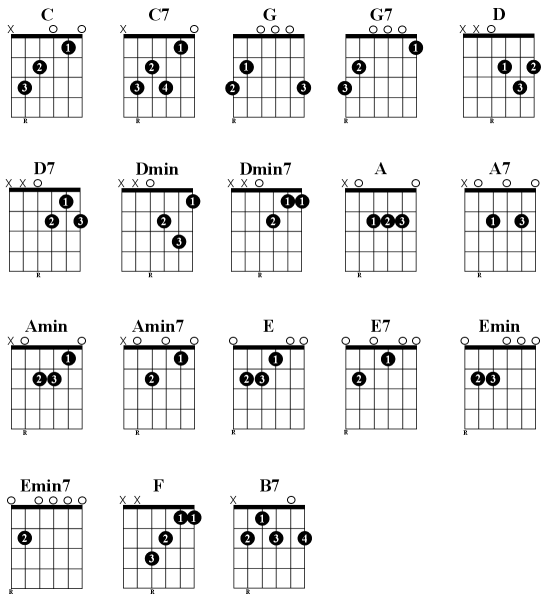
Chord Sheet 1 (Cs01)
These are the first chords that you will be learning. The numbers on the chord diagrams (boxes) refer to the fingers on your fretting hand, with your index finger being "1" and your little finger being "4". An "X" above a string denotes that that string is not played and a "0" denotes an open (unfretted) string.

All of the chords should be played so that each string plays cleanly. The usual reasons that a string doesn't play cleanly are as follows:-.
- You are not using your fingertips to play the chord. One or more of your fingers maybe touching one of the other strings and not allowing it to vibrate.
- You are not placing your fingers in the middle of the frets.
- You are not applying enough pressure to the string.
When you can play all of the chords cleanly, then try practicing changing from chord to chord, start off slowly and gradually increase the speed at which you change the chord.
N.B. When playing F and Dmin7 your first finger frets the notes on both the first and second strings.
As a beginner you have to build strength in your hands, fingers and forearms. You will initially find that playing and changing chords is quite tricky and uncomfortable. As your strength increases and your brain gets used to the new things you are asking it do, you should notice a steady improvement in both your accuracy and speed of chord changing.
You will no doubt suffer at some point from sore fingers and aches in your arms, don't worry this is normal. Since we are building strength I suggest that you practice little and often. There is little point in practicing once a week for four hours, four or five times a week for quarter of an hour would be much better.
Guitar & Bass Lessons, Repairs, Setups & Customisations in Walsall
Website designed and produced by Paul Waring (pmwaring@hotmail.com)
Copyright ©2001-2025 Paul Waring, All Rights Reserved.